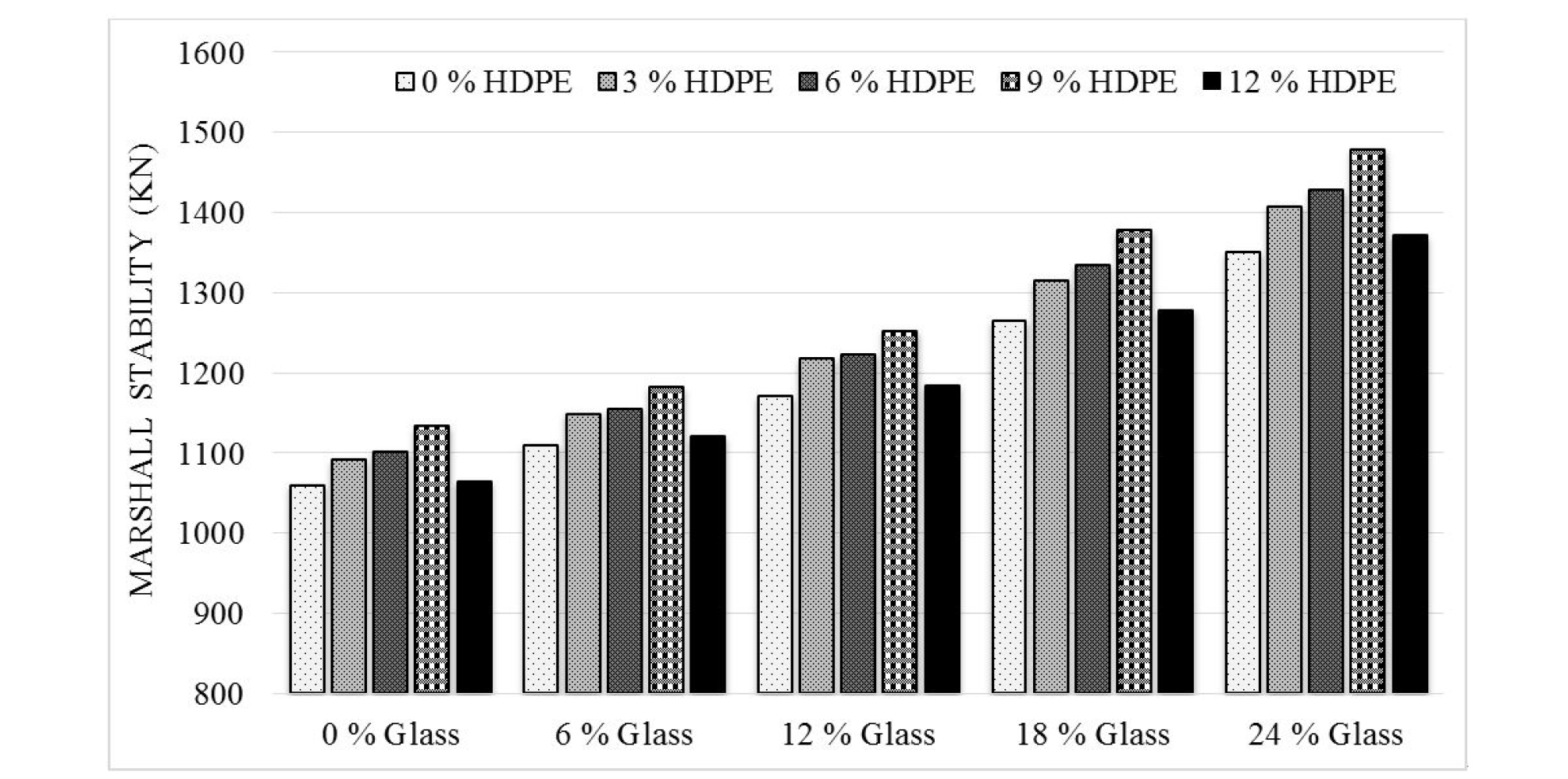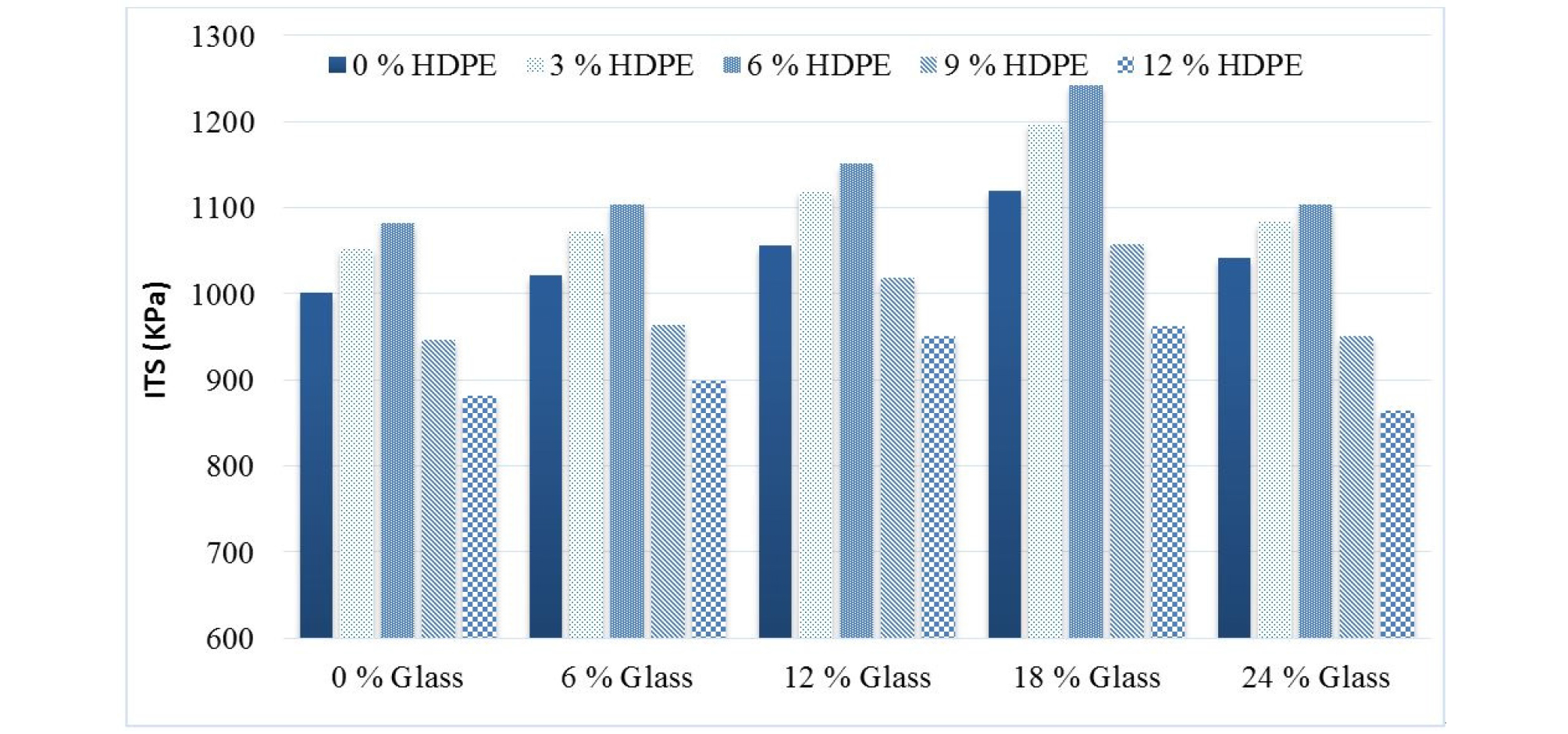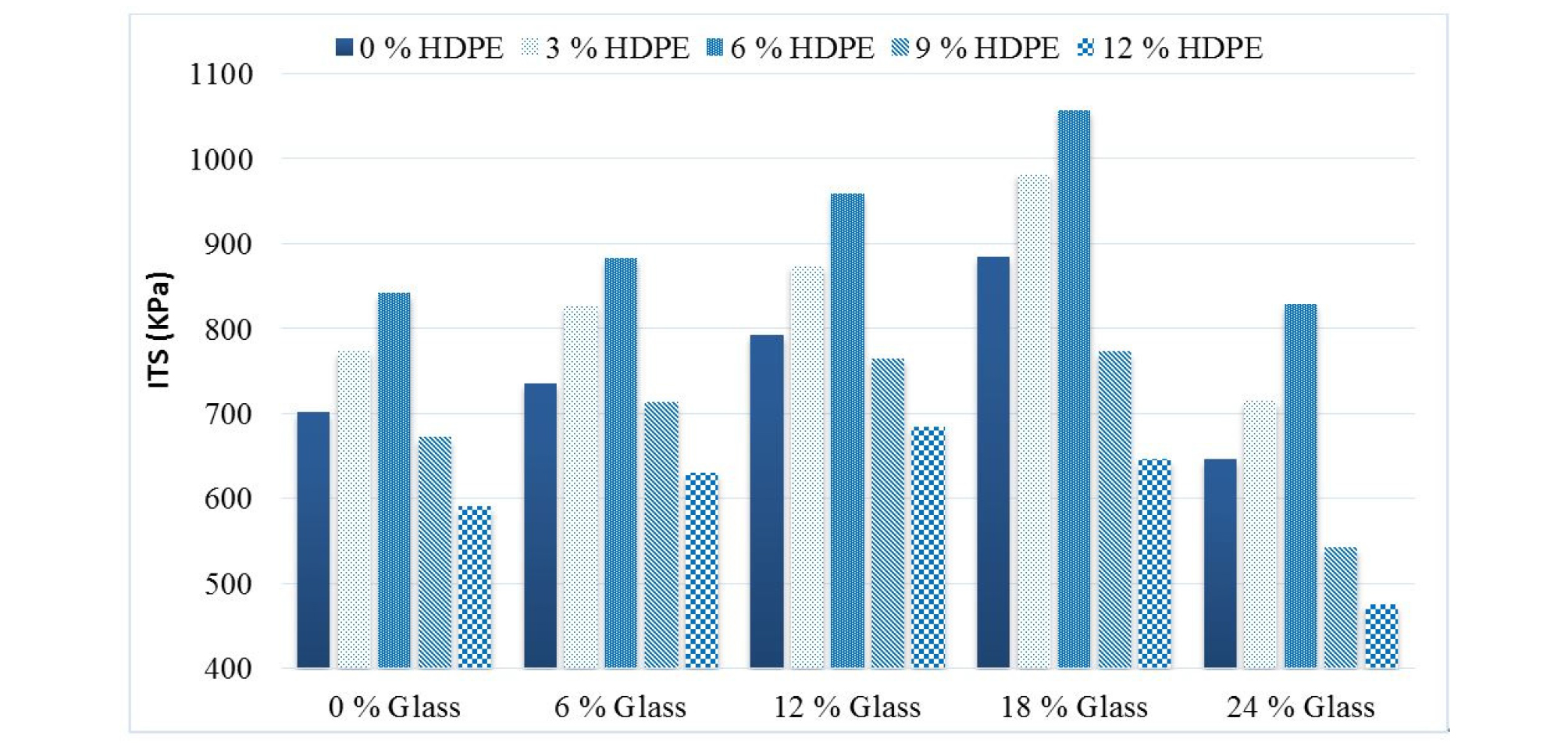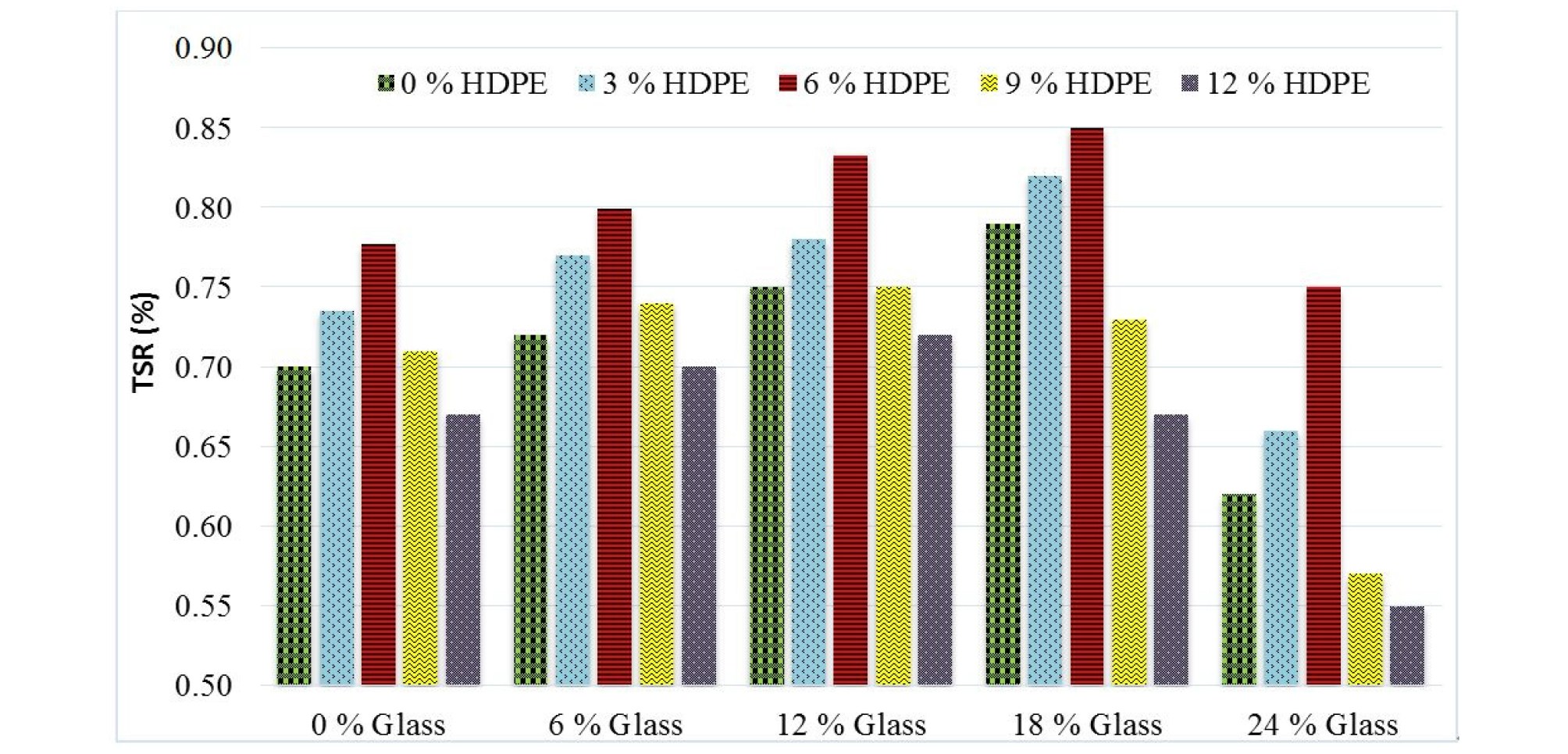Introduction
Material and Methodology
Aggregates
Asphalt binder
Waste Crushed Glass
HDPE
Sample Preparation
Laboratory testing program
Marshall Stability
Moisture susceptibility test by the AASHTO T283 method
Result and Discussions
Marshall Stability
4-1- ITS
Conclusions
Introduction
Nowadays, with the advancement of science and technology, the main materials used in civil engineering have been modified or changed in order to improve their engineering properties and reducing the costs of projects [1, 2]. In doing so, innovations emerged in the concrete additives in order to increase the concrete strength together with diminishing the cost and weight [3, 4, 5], geo-mechanical properties of the problematic soils have been modified by new materials and methods [6, 7, 8] and novelties in the constructing methods of all types of asphalts are only a few cases of the application of modern sciences and technologies in the civil engineering world [9, 10, 11, 12].
Finding a new method to decrease the waste materials is abounded in our environment by recycling and applying them as an additive for improving the engineering properties of the asphalt mixtures, has been an interesting research topic in civil engineering. The usage of industrial byproducts and recycled materials in the pavement structures, is increasingly favorable. Especially in the hot mix asphalt due to their economic and environmental benefits [13].
Singh et al. in 2017 conducted a research study on the asphalt mixtures by adding the waste polyethylene bags. In fact, they preferred to find new materials originated from the urban municipal waste with the aim of decreasing the costs and environmental issues. They showed that polyethylene improves the bonding between the aggregates, increases the strength, flows the properties and elasticity. Finally, they indicated reduction in temperature susceptibility of asphalt binder [14].
In a laboratory investigation carried out by Arabani et al. in 2017, the effect of the different waste materials (including waste glass powder (WGP), waste brick powder (WBP), rice husk ash (RHA) and stone dust (SD)) on HMA mixtures were evaluated using the indirect tensile fatigue test (ITFT), Marshall and indirect tensile stiffness modulus (ITSM) tests. This comprehensive research work has concluded the best stable value for the mixture with WGP, followed by WBP, SD and RHA. Moreover, ITFT results which indicated the use of WGP and WBP as fillers, improve the fatigue behavior of the mixtures by increasing the fatigue life and reducing the final strain [15]. Thus, according to above study’s evaluation and due to the shortage of natural resources and presence of countless environmental issues, waste materials can be investigated more in order to be utilized in the construction.
Guo et al. in 2015, examined the effects of glass fiber and diatomite compound on the asphalt mixture. These compound performances were evaluated via several experimental methods including the Wheel tracking test, low temperature indirect tensile test, ITFT test and ITSM test. They concluded that the diatomite and glass fiber improve the fatigue properties and rutting resistance of the control asphalt mixture [16].
Considering the waste materials used in our current project, it is worth mentioning that in many investigations conducted on hot mix asphalt (HMA) wasted glass has been used in HMA as a filler [17, 18, 19]. However, in the current study, a laboratory procedure of hot mix glass asphalt (HMGA) including the waste plastic bottles as a kind of known high-density polyethylene (HDPE) was discussed. HDPE samples were prepared in the laboratory for the experimentations. Marshall stability and indirect tensile test (ITS) were conducted on different combinations to evaluate their behavior.
Material and Methodology
Aggregates
The gradation of the limestone aggregates used in the current study have been selected based on the ASTM standard presented in Table 1. It is clear that the asphalt mixture is considerably affected by chemical and physical characteristics of the aggregates. The physical properties of the aggregate are given in Table 2.
Table 1. Applied grading of the aggregates and glasses used in the present study
Table 2. Physical properties of aggregates used in this research
Asphalt binder
Asphalt binder used in this laboratory investigation was the pure type with the penetration grade of 60/70, which had been provided from the Pasargad Oil refinery. The specifications of the asphalt binder are presented in Table 3.
Table 3. Engineering properties of asphalt binder used in this research
Waste Crushed Glass
The utilized crushed glasses were firstly passed through the sieve NO. 4 (4.75 mm opening) and the percentages of smaller sieves are provided in Table 1. In this study, 6, 12, 18 and 24% content of waste crushed glasses (WCG) in compare with the asphalt binder weight were applied. Some of the chemical contents of the utilized glasses in the laboratory investigations are listed in Table 4. The specific gravity of the crushed glasses were estimated as 2.4 gr/cm3.
Table 4. The chemical composition of waste crushed glass
| Constituent elements (%) | |
| Sio2 | 72.21 |
| Cao | 9.77 |
| Fe2o3 | 0.71 |
| Al2o3 | 0.94 |
| Mgo | 3.53 |
| K2o | 0.41 |
| SO3 | 0.27 |
| Na2O | 12.04 |
| TiO2 | 0.04 |
| P2O5 | 0.01 |
| Mn2O5 | 0.01 |
| Cr2O3 | 0.02 |
HDPE
In this investigation, 3, 6, 9 and 12 % content of high density polyethylene (HDPE) in comparison with the asphalt binder weight were used. In order to remove the coarse particles, HDPE particles were firstly passed through the sieve NO. 100 and 200. Table 5 presents the properties of Polyethylene used here.
Table 5. Properties of Polyethylene used in this study
Sample Preparation
All samples were prepared using Marshall mixing method. 24 samples were made by the different percentage of asphalt binder contents in combination with 6, 12, 18 and 24% WCG to find the optimum percent of bitumen by Marshall Test. The optimum binder content (OBC) was determined as 5.5 %. Then, 3, 6, 9 and 12 % HDPE were added to each sample made with optimum content of asphalt binder and mentioned percentages of WCG.
Laboratory testing program
Marshall Stability
To investigate the mechanical and physical properties of hot mixed glass asphalt with or without HDPE, the Marshall Stability test was applied with the ASTM D1559.
Moisture susceptibility test by the AASHTO T283 method
In this study, the AASHTO T283 standard has been applied to investigate the HMA performance against the moisture damage. Also, in order to examine the modified Lottman method for each mixture, three samples should be made in dry conditions and three in wet conditions. Hence, to simulate wet conditions, the samples were first saturated for 5 minutes under relative vacuum conditions (absolute pressure 13-67 kPa). After that, they were kept for 5-10 minutes in a submerged state under the absence of vacuum conditions. Then they were taken out, their mass was measured, and the percentage of sample saturation was calculated. The vacuum conditions should be to the extent that the saturation percentage of the samples is between 70 and 80% [20].
Saturated samples were put in plastic bags and 10 ml of water was poured into them. Samples were kept in the fridge at -18°C for 16 hours. After that, they were immersed in a hot water bath, which its temperature was 60°C. Then, they have been removed from the plastic bags and have been allowed to remain at this temperature for 24 hours. Finally, the samples were brought to a temperature of 25°C [21]]. The ITS test is carried out at a loading rate of 2 inches per minute until the sample ruptured. The amount of load was recorded at the moment of the rupture. By using equation (1), the amount of indirect tensile strength is calculated for each of the six samples [22]:
| $$ITS=\frac{2F}{t\mathrm{πd}}$$ | (1) |
In the above-mentioned equation, ITS is the amount of indirect tensile strength (kPa), F is the force at the failure moment (kN), t is the thickness of the asphalt sample (cm), and d is the diameter of the asphalt sample (cm). The moisture susceptibility or in other words the potential for stripping of the HMA samples is calculated as a result of equation (2) with the average ratio of the indirect tensile strength of the wet to dry samples [23]:
| $$TSR=\left(\frac{ITS_{wet}}{ITS_{dry}}\right)\times100$$ | (2) |
Where TSR is the indirect tensile strength ratio (%), is the average of the indirect tensile strength of the wet samples (kPa) and is the average of the indirect tensile strength of the wet samples (kPa).
Result and Discussions
Marshall Stability
The Marshall stabilities of HMGA and HDPE-modified mixtures are presented in Figure 1. As can be seen, by increasing the WCG content, the Marshall Stability increases compared to the controlled mixture. Also, along with increasing HDPE content in HMGA, results indicated that the Marshall Stability increases up to 1250 KN which is the maximum value for mixtures with 9% of HDPE content. By further increment in the HDPE and WCG contents, the HMGA stability under the compressive stresses have reduced to some extent. This can be attributed to the rise in asphalt binder viscosity in the presence of the polymer [24].
4-1- ITS
The results of the ITS test in dry and wet conditions are presented in Figure 2 and 3 respectively. As would be observed from the test results, using HDPE in HMGA, increases their ITS values about 7 up to 24% in comparison with non-HDPE glass asphalt samples.
This resistance improvement to the moisture occurs up to the amount of 18% WCG content and more increment may reduce the resistance to the moisture susceptibility. Furthermore, adding HDPE to HMGA to the amount of 6%, results into the resistance improvement of the samples. Therefore, the combination of 18% WCG and 6% HDPE, is the best one for the resistance of asphalt mixtures against moisture susceptibility. In other words, adding HDPE amounts, increase the adhesion and continuity in the HMGA mixtures and it does not allow the rapid transfer of the asphalt binder from the surface of the aggregates and makes the mixtures to have a higher moisture resistance than non-HDPE samples.
The TSR results are presented in Figure 4. Based on these results, it can be clearly observed that the use of WCG content (18% and lower) has led to an improvement in the resistance of modified HMA as compared to the controlled samples. Also, HDPE modification improves the moisture susceptibility of HMGA but the enhancement reduces by using a higher percentage of HDPE (9% and higher) which can be attributed to the asphalt binder workability reduction in the presence of HDPE addition.
Conclusions
The present study investigated the influence of the HDPE usage as an asphalt binder modifier on the moisture susceptibility of HMGAs. The most significant results according to the ITS and Marshall Stability tests are given as below:
1)Increasing the WCG amount, the Marshall resistance of all asphalt mixtures are increased compared to the controlled ones. Also, the asphalt binder modification of the HMGA mixtures using HDPE increases their Marshall resistance in comparison with the controlled and unmodified HMGA samples. However, this increase will be up to 9% HDPE and higher values will reduce the Marshall resistance.
2)The asphalt binder modification of the HMGAs using HDPE, leads to an increase of 7 to 24% in the ITS values compared to the HMGA samples with no HDPE. The combination of 18% WCG and 6% HDPE, is the best one for the resistance of asphalt mixtures against moisture susceptibility.
3)According to the TSR results, the combination of WCG and HDPE leads to an improvement in the performance of asphalt mixtures against moisture susceptibility. And values of more than 6% HDPE reduce the performance of the asphalt binder and aggregate system against stripping.








